
SIGN OR CLICK?
The world is becoming more digital, electronic documents exchange forced many legislations to implement the laws on electronic (digital) signature, such as (e.g., eIDAS in the European Union, NIST-DSS in the USA).
A list of devices for qualified signatures as notified to the EU Commission by Member States is available here.
The idea of electronic signature is efficient on many levels – it saves time, costs and the planet, by being more environment friendly. Taking into account all the advantages of the electronic signatures, why do we still have to print out contracts and collect wet-ink signatures? Let’s review some reasons:
• All or one of the parties don’t have technical infrastructure to sign the contracts electronically. Paradoxically, technology can impact the most technological way of signing contracts. Electronic signature requires specific software, and sometimes devices, that are very often not available at sites. Besides, for example, in Russia it has been impossible to sign electronically using computers that had other operational system than MS Windows.
• Gaps in the legislation. In some jurisdictions the legislation on electronic signature, even if it is detailed and clear, simply does not work in practice. The process of signing and recognition of the electronic signature may be so complex and formalised, that it is easier and safer to sign ‘traditionally’, wet ink.
• Recognition of signature of the foreign party. This can be an issue if, say, sponsor and site being contract parties belong to different jurisdictions that do not recognise electronic signatures of each other.
• Old style approach. Some sites, especially in Europe, are just reluctant to upgrade their usual document management processes.
Thus, electronic signature in some regions is still at the stage of ‘some good idea’. Widely used in the North America, it is still a subject of some nonconfidence in Latin America or parts of Europe.
It is clear, the countries should pay more attention to this topic as, as pandemic has shown, electronic signature may also be treated as safety measure.
We hope in some near future signature of any clinical trial agreement will be a matter of one or a few click/s.
